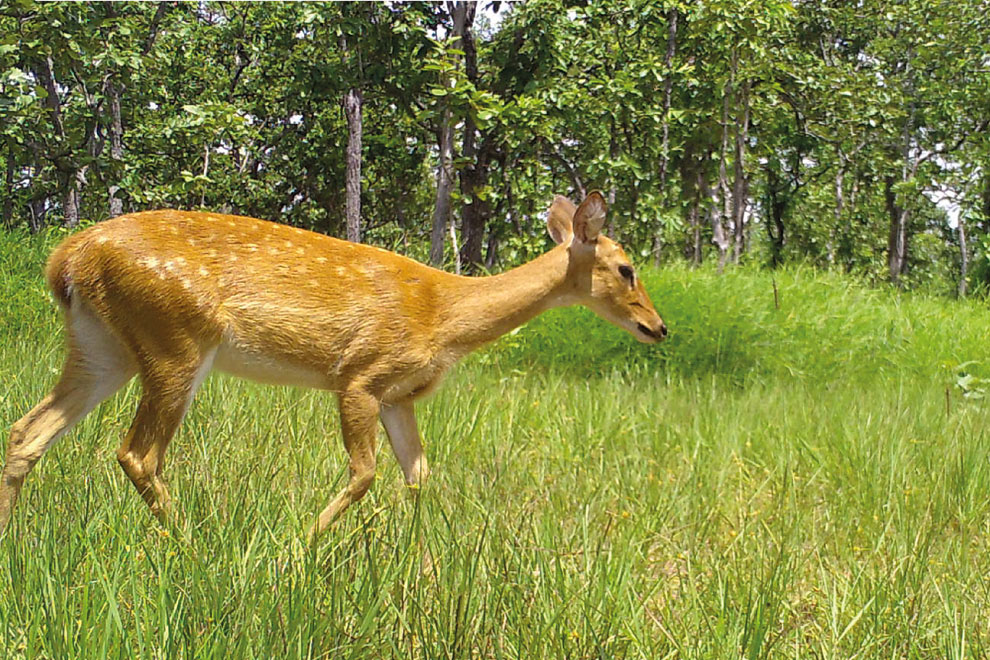
Eld's deer, known by its scientific name as Rucervus eldii, was recently photographed for the first time in five years in the Sambor Wildlife Sanctuary, a nature reserve in the Mekong Flooded Forest Landscape in Kratie province. WWF
Eld's deer, known by its scientific name as Rucervus eldii, was recently photographed for the first time in five years in the Sambor Wildlife Sanctuary, a nature reserve in the Mekong Flooded Forest Landscape in Kratie province.
A World Wildlife Fund (WWF) press release on Thursday said camera traps captured images of four of the deer, an event that raises hopes for the conservation of the endangered species in the country and region.
The species is listed as endangered in Cambodia’s Forestry Law and is listed on the International Union for Conservation (IUCN) of Nature Red List.
Conservationists are thrilled to see the rare images of Eld’s deer roaming the Sambor Wildlife Sanctuary, as they examined 1,710 photographs produced between August and September by the camera traps that were deployed at different locations in the sanctuary which covers 50,093ha.
Aside from Eld’s deer, the photographs documented the presence of red muntjacs, wild pigs, small Indian civets, common palm civets, and large bird species such as the endangered green peafowl and vulnerable lesser adjutant.
WWF country director Seng Teak said: “The photographs provide evidence that our conservation efforts are paying off, raising hopes for the protection of the animal in the country and region.
“We commend all law enforcement actors for regularly patrolling the wildlife sanctuary and reinforcing the implementation of the protected areas and Forestry Laws.
“These efforts are a major deterrent to forest and wildlife crimes, thus helping wildlife to be free from fear and stress as they live in a safe environment of the sanctuary.”
Ministry of Environment spokesman Neth Pheaktra told The Post on Thursday that it was delighted about the discovery of the four Eld’s deer and thanked all relevant parties involved in the protection and conservation of natural wildlife resources in Cambodia.
“The presence in Cambodian protected areas of Eld’s deer, which is an endangered species in the world, confirms the effectiveness of the conservation and prevention of natural resource crimes, especially that of hunting animals and wildlife trapping,” Pheaktra said.
He said the ministry, together with relevant authorities, continue to implement the rules of protection and conservation of protected areas under its management with a sense of responsibility and acts on all natural resource crimes.
In the first six months of this year, ministry rangers conducted 13,804 patrols and cracked down on 3,689 cases. Of them, 329 were sent to court. Authorities also confiscated 2,578 vehicles while fines were issued in 433 of the cases.
At this point, Pheaktra said the ministry recognises that despite efforts to prevent and crack down on crimes day and night, small-scale natural resource crimes still occur. The ministry will continue to cooperate with relevant authorities to crack down and further prevent wildlife crimes.
The ministry said Cambodia is rich in biodiversity. It includes 123 species of mammals, 545 species of birds, 88 species of reptiles, 2,308 species of vascular plants, 874 species of fish, 24 species of hard coral, 14 species of soft coral, 10 species of seagrass and 63 species of sea mammals.
There are still plants and animals that have yet to be identified as well.
A report on endangered species released by the IUCN in 2015 showed that the remaining Eld’s deer population is scattered around the world. It is estimated that there are less than 700 of them left, with very few living in protected forest areas in Cambodia.




.jpg)










